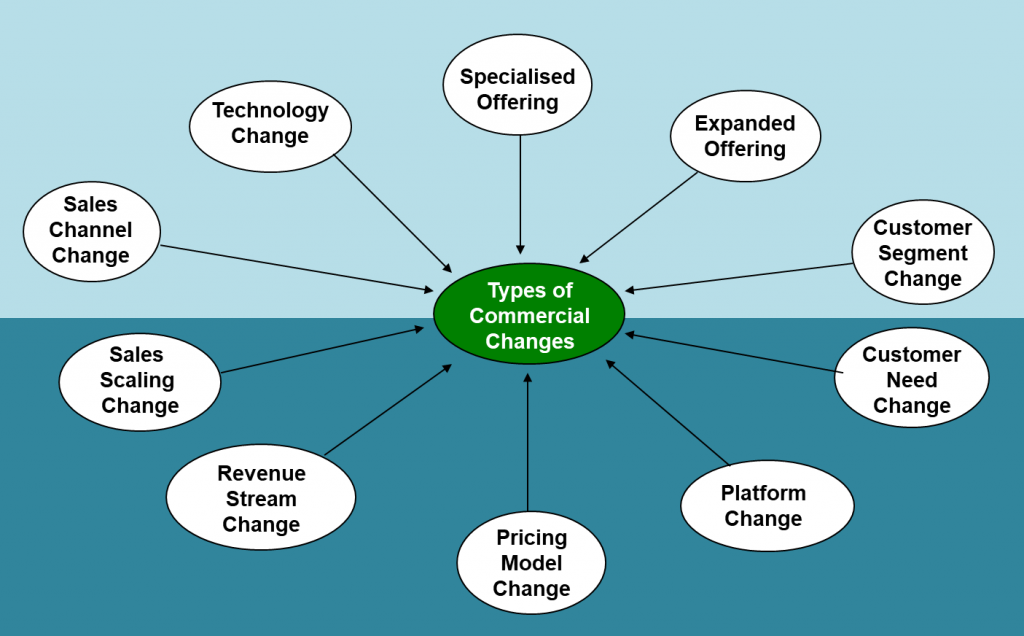
Changing Commercial Strategy – Advice and Tips
Changing Commercial Strategy – It should be standard practice for company leaders to review the commercial strategy which their company is adopting. The first decision which they must decide on is whether to persevere with the current plan or change it.
Companies must always focus on ensuring that their products and processes are aligned to create value and drive growth.
To decide on whether changing commercial strategy is required, these leaders need to ask one fundamental question; “Are we making sufficient progress to believe that our original strategy is correct, or do we need to make a major change?”
This article will give oversight on why companies struggle to change their commercial strategy and what they need to do to overcome this challenge. It will also outline different types of changes to a commercial strategy which a company can adopt.
Three Reasons why Companies are slow to make changes
Most companies struggle to conduct a review of their commercial strategy properly. The main reasons why this happens is due to:
1. Vanity Metrics – Many companies are using incorrect or short vision metrics to measure the progress of their business. Certain biases may reflect how these metrics have been designed or how they are interpreted. The goal may be to highlight what the leaders expect to see and not what is happening to the company or the industry in which it operates. An example of this is the banking industry pre the 2008 financial crises. In this instance, the metrics focused on short term profit information. However, there was no meaningful metrics on the systematic risk provided to investors or regulators.
2. It is too late to make changes – it can be difficult for the company to make any drastic change to a strategy as it may have already invested a considerable amount of resources into the incorrect strategy. Some companies may struggle to access funds to enable a change to a new approach.
3. Fear – Many leaders are afraid that their vision might be deemed wrong before giving it a “real” chance to prove itself. They also might fear when changing commercial strategy may lead to reputational and political fallout.
A suggested approach to successfully create a process for reviewing the commercial strategy
1. A company culture of Continuous Improvement needs to be instigated.
2. It should become standard practice to review the performance of a company’s strategy and decide regularly. These “Strategy Change or Persevere” meetings should be held every 8/12 weeks.
3. All metrics used to review a strategy should be continuously challenged by all participants.
4. All departments and business leadership teams should be actively participating in these meetings. It would also be advantageous to bring in outside consultants or third parties advisors to assist the companies leaders in overcoming any biases.
Changes to a Commercial Strategy – So What?
There are ten potential changes that a company can implement when changing its commercial strategy.
It is always worth noting that any change to a commercial strategy may not necessarily mean dispensing with the current commercial approach and starting over. Instead, it could be about evolving the current version into one that can move the company into a more positive direction.
If changes are to be made, these changes should focus on one of the following areas of the company:
- The products that the company offers.
- How the company promotes and sells these products.
- The processes, practices and procedures that operate within the company.
(10 types of commercial changes)
1. Specialised Offering
Here a decision is to reduce the company’s offerings and instead specialise on a particular product or service. The company can use it to stabilise the business, develop sales or use as a foundation to build a brand. A focus should be on building recognition within the market and industry for delivering quality. It may be required to restructure the company to remove costs associated with other legacy products. Examples of firms who adopted this strategy include Zippo Manufacturing Company and McIlhenny Company (Tobasco).
2. Expanded Offering
In this instance, a decision is to seek to expand the current number of products offered to the company’s existing customers. It is a low-cost option as the company can use its existing sales, marketing and distribution channels. There is also an opportunity to acquire new customers who may require a “One Stop Shop” provider to meet there needs. Examples of firms who adopted this include Apple and Unilever.
3. Customer Segment Change
The company offers a product that solves a real problem for real customers; however, there may be a decision required to change the type of customer which is being offered this product.
Examples of firms who adopted this include Boeing who initially developed the 747 as a military vehicle transport plane but moved to target airlines that carry people. Kimberly Clark created a dressing to treat wounds in WW1 but switched to focus on target women to use the product as a sanitary pad.
4. Customer Need Change
The company has an excellent customer base and great communications with these customers. However, these customers don’t value the current services or products which are being offered to them. To correct these issues, the company needs to identify other essential problems these customers may be experiencing and deliver a product to address that addresses this need.
Examples of firms who adopted this include Peugeot who moved from producing bicycles into producing cars to meet their customers demand engine powered transport instead of just pedal transport.
5. Platform Change
This is a change in the way which the company enables its customers to access its services or products. It may be required as a new generation of customer comes into the market.
Examples of industries who adopted this include – Banking who offer their services online as well as at local branches. Airlines have moved away from ticket sales to ticketless bookings.
6. Pricing Model Change
In business, there are generally two pricing models which companies use:
- High Margin – Low volume
- Low Margins – High volume
If a company is considering switching its pricing model, it must undertake a full cost-benefit analysis of the proposed change. This analysis should also review the potential targeted market value and provide a new set of financial targets and metrics to assess performance.
The company should also conduct a full audit on the resources required to restructure its processes, practices and procedures to implement the new model.
Examples of this strategy being used are those farmers who have switched from selling their products through wholesales to selling direct to customers.
7. Revenue Stream Change
A company can use many streams to generate revenues and add value. A company may decide to change or bring in new streams to generate revenues. Revenue streams can include the following:
- Transactional Revenue Model.
- Product is Free, But Services Aren’t.
- Subscription Revenue Model.
- Ad-Based Revenue Model.
- Affiliate Revenue Model.
- Freemium Model.
Examples of these include movie companies that not only generate revenues from people watching a movie but also from product placement within the film and merchandising products to those who watched the movie. Star Wars is an example of this; it has made over $70 billion from merchandising alone.
8. Sales Scaling Change
There are three main methods that companies can adopt to develop and scale their sales. A company can decide on a single process or a combination of several processes. This decision can depend on the type of product, the stage in the lifecycle which the product is at:
A. Paid Promotion – So what
It is the most traditional and common form of scaling sales. Paid advertising can be successful in the early phases. It is beneficial for establishing new products or launching into a new market. However, it is the most expensive way to generate sales growth. For an established product, then, the company should also consider alternative less costly methods of scaling sales.
B. Selling More to Current Customers – So what
This model of scaling involves selling more products to the company’s current customer base. It is a low-cost way to scale sales. If using this method, the focus should be on having quality relationships and communications with the customer. It will enable the company to identify other potential products or services to offer to these customers.
C. Word of Mouth Growth
Customer referrals are a fantastic and cost-effective way to scale sales. Having a customer recommend and endorse products to other potential customers not only builds sales, but it also builds the reputation of the company. This scaling strategy is only suitable for firms that have a proven market for their products.
An example of a company that adopted this strategy is Amazon. It initially focused on offering online books and CD it grew its sales through paid advertising and word of mouth. It then diversified its ranges and sold more to these customers.
9. Sales Channel Change
Any commercial strategy must include the channels where a company’s customers can acquire its products. It is critical for those companies that are seeking to expand and develop sales into international markets. It is vital that a full analysis before deciding which channel to adopt. Types of sales channels include
- Direct Sales.
- Indirect Sales.
- Retail Sales.
- Online Sales.
Companies can offer their products through several sales channels at the same time. An example of this is Sony which offers its products via its stores, through distributor companies and online.
10. Technology Change – So What
Some industries can regenerate sales for products through new technologies. Companies may target those customers who are already using these products and promote the additional benefits which a new technology adds to the product. The key questions a firm should ask itself when considering this option is: “Why would this technology encourage a customer to repurchase the same product again”?
An example of this is the music industry. In this instance customers may have purchased an album initially as a vinyl record, they then repurchased the same album when it was issued as a CD as it offered better sound. Those same customers may have repurchased the same album for the third time as a download to be used on their phones.
Conclusion
In conclusion, therefore the biggest challenge for decision-makers in a company that is deciding to change commercial strategy is to be able to accurately and adequately assess what is happening within their market and to be able to position the company so that it can drive growth and create value from this market.
Continuously review the current commercial strategy and if required change it.
A company should conduct a proper review of the full implications of a change in three areas:
- The products that the company offers.
- How the company promotes and sells these products.
- The processes, practices and procedures that operate within the company.
Changing Commercial Strategy – About the Author
Aidan Conaty ACMA, GCMA, MBA, is the founder of TCI China and Goodada.com. Aidan has spent over 15 years assisting companies to trade internationally. TCI China provides trade support services for China. Goodada helps companies to sell globally. Trinity College Dublin awarded Aidan the Seamus McDermott MBA scholarship.
Aidan can be contacted email at aidan@goodada.com or at:
(Europe/ Rest of the World) +353 1 885 3919
(UK) +44.020.3287.2990
(North America) +1.518.290.6604


